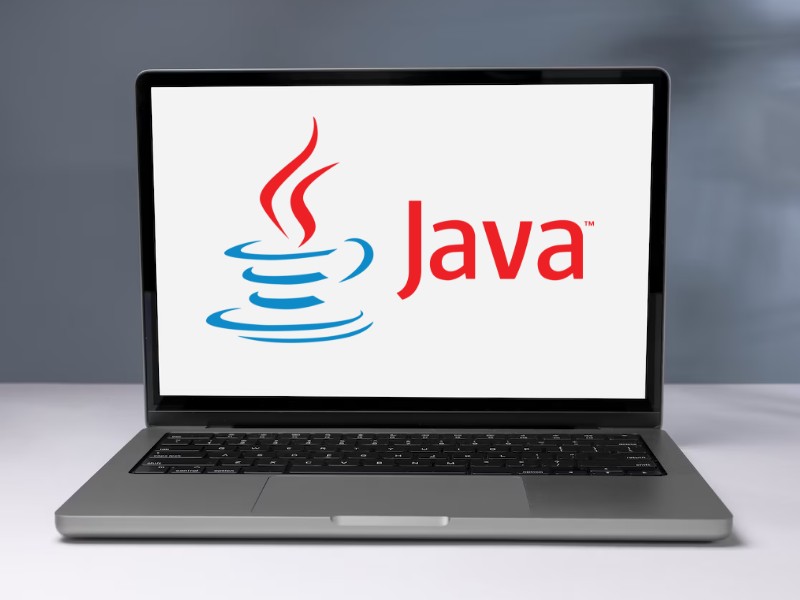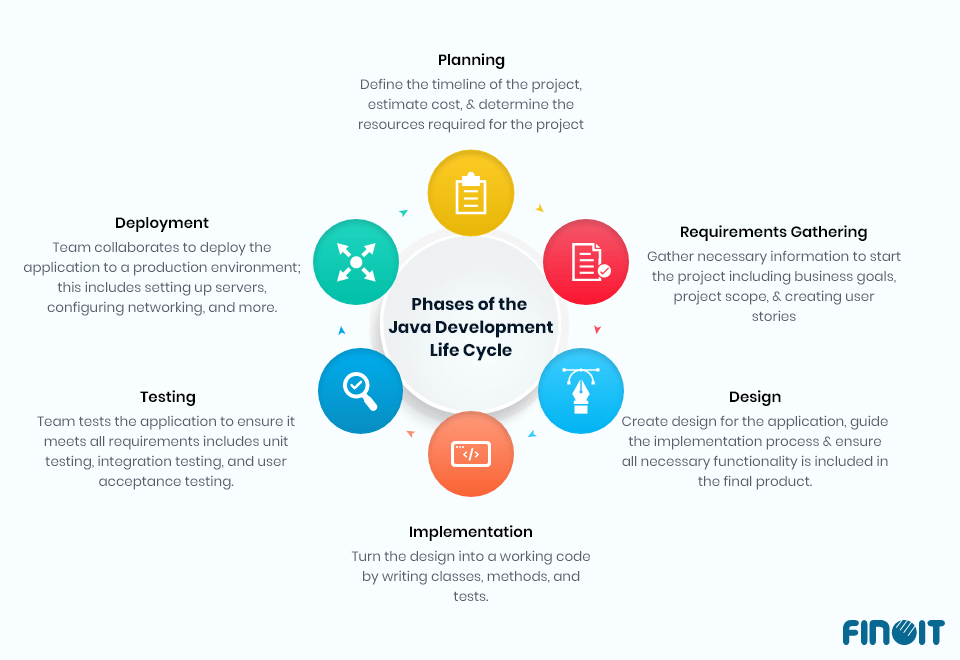What Is Java Development Life Cycle: 6 Important Phases in Java Software Development

When choosing to develop a software application with Java, a key element that one needs to keep in mind is the Java development life cycle and methodology. Java development companies have a comprehensive knowledge of different Java methodologies and make wise choices in adopting the right Java project approach.
Keeping this in mind, in this blog post, we will look at the different stages of the Java development lifecycle and some common methodologies and approaches used in Java development.
What Are the Phases of the Java Development Life Cycle?
In Java application development, the Java development life cycle comprises the following phases:
- Planning
- Requirements Gathering
- Design
- Implementation
- Testing
- Deployment.
Before we go into the details of each of these phases, let’s first understand the components of Java. When developing Java applications, it is essential to understand the difference between the Java Development Kit (JDK), the Java Runtime Environment (JRE), and the Java Virtual Machine (JVM). JDK is a software development kit that contains the tools needed to compile and run Java applications. The JRE is a runtime environment containing the JVM, the software that executes Java code.
Also read: Is Spring best Java framework?
The JRE also includes class libraries and other resources needed by the JVM. The JVM is what runs Java code. It is a virtual machine that interprets Java bytecode and produces output. The JVM is platform-independent, meaning that it can be used on any operating system.
The JDK, JRE, and JVM are all necessary for Java development. The JDK is needed to compile code, the JRE is required to run code, and the JVM is needed to execute code.
Now, we’ll take a walk through the different phases in Java software development:
First Phase
Planning: Here, project owners and project managers collaborate to define the timeline of the project, come up with cost estimates, and determine the resources required for the project. They define quality metrics, milestones, deliverables, and dependencies, and decide on the responsibilities of each member.
Second Phase
Requirements gathering: The second phase of the Java development process is requirements gathering. In this phase, the team works together to gather all of the information necessary to start the project. This includes understanding the business goals, determining the project’s scope, and creating user stories.
Third Phase
Design: The third phase of the Java development process is design. In this phase, the team works together to create a high-level design for the application. This design will guide the implementation process and help ensure that all necessary functionality is included in the final product.
Fourth Phase
Implementation: The fourth phase of the Java development process is implementation. In this phase, the team works together to turn the design into a working code. This involves writing classes, methods, and tests.
Fifth Phase
Testing: The fifth phase of the Java development process is testing. In this phase, the team works together to test the application to ensure it meets all requirements. This includes unit testing, integration testing, and user acceptance testing.
Sixth Phase
Deployment: The sixth and final phase of the Java development process is deployment. In this phase, the team collaborates to deploy the application to a production environment. This includes setting up servers, configuring networking, and more.
The Java development life cycle is a complex process involving several steps and activities. The choice of methodology and process can have a significant impact on the overall success of the project. Choosing the right approach for your team and your project is essential.
Java Development Methodologies
Java development methodology is the set of practices and processes a team follows when developing a Java-based application. Several different Java development methodologies are available, including Agile, Scrum, Waterfall, and more.
When planning a Java development project, choosing your team’s methodology and the process is essential. The choice of methods and processes will impact the overall success of the project. Discussed here are key methodologies used in Java application development.
- Agile: It is a popular choice for Java development projects. Agile is an iterative and incremental approach to software development. It focuses on delivering working software quickly and efficiently.
- Scrum: The Scrum methodology is another popular choice for Java development projects. Scrum is an agile framework that helps teams work together more effectively. Scrum enables developers to deliver working software in short cycles, called sprints.
- Waterfall: The Waterfall methodology is a traditional approach to software development. Waterfall involves completing all phases of the development process before moving on to the next phase.
- Kanban: Kanban is a popular development methodology that has recently gained traction. Kanban is a Japanese word that means “signboard” or “billboard,” and the methodology is based on just-in-time manufacturing principles. The basic idea behind Kanban is to make the development process more efficient by reducing wastes in the software development lifecycle and ensuring that tasks are completed as efficiently as possible. To do this, Kanban uses several techniques, including:
- Visualization: All tasks are represented by cards, which are then placed on a board. This allows everyone involved in the project to see the status of each task at any given time.
- WIP Limits: Work in progress (WIP) limits are imposed to prevent team members from becoming overloaded. This ensures that tasks are completed more quickly and reduces the chances of errors.
- Continuous Improvement: The Kanban methodology is based on continuous improvement, which means that teams constantly look for ways to improve their processes.
- Iterative development: It is a popular software development methodology involving repeated development cycles, testing, and feedback. The basic idea behind iterative development is to make small changes to the software in each cycle and then test and evaluate those changes before moving on to the next cycle. This allows for a more flexible and responsive approach to development, as changes can be made based on feedback from users or testers. There are a few different ways to implement iterative development, but the agile methodology is one of the most popular. Agile is an iterative approach focusing on delivering working software quickly and efficiently.
If you’re thinking of using iterative development for your next project, you should keep a few things in mind. First, it’s essential to clearly understand your workflow and how each cycle will fit into the overall development process. Second, be prepared to make changes to your plans as you go – the whole point of iterative development is to be flexible and responsive to feedback. And finally, ensure you have a good testing strategy in place – this will be crucial to ensuring the quality of your software.
Other Java Development Methodologies
There are several other Java development methodologies, each with advantages and disadvantages. Some of the most popular include:
- Spiral: The spiral methodology is similar to the waterfall approach but emphasizes risk management. This means that tasks are completed in small cycles, each addressing a different risk. This one is a good approach for large and complex projects.
- Prototype: The prototyping methodology involves creating a working software model, which is then used to gather user feedback. This feedback is then used to improve the design of the final product. This can be a good option if you are unsure about what your final product will look like.
- Rational Unified Process (RUP): RUP is a more structured approach to development that involves dividing a project into phases. Each phase has its own goals and deliverables, and teams work on one phase at a time. This can be a good option for larger projects with multiple teams working on different software parts.
- Feature-Driven Development (FDD): FDD is an agile methodology that focuses on delivering small increments of working software. This can be a good option if you work on a project with tight deadlines.
- Rapid Application Development (RAD): Another popular methodology focuses on delivering working software quickly. This can be a good option if you need to get your product to market quickly.
- Big Bang: The big bang developer model is a less formal approach to development that focuses on delivering working software as quickly as possible. This can be a good option if you’re working on a small project with a tight deadline.
Wrapping Up
A continually improving and adaptive software development methodology is an essential element of any software development project. A software development project requires an evolutionary approach so that managing changes becomes easy. Java software development is no exception to this.
With proven experience in implementing Agile methodologies, Finoit, as a Java development company has exposure to developing applications using the latest software development project management tools and techniques. Our cost-effective custom software development service with on-time delivery within your budget will surely simplify your application development journey.

FAQ
What is the Java development lifecycle?
This is what stages of development a project goes through. Including planning and ending with the release.
What is coding in SDLC?
After the system design phase is completed, the coding phase begins. During this phase, developers begin building the entire system by writing code in the programming language of choice.
Which SDLC model is best?
According to the annual State of Agile report, Agile is the best SDLC methodology and one of the most widely used SDLCs in the tech industry.
Why should one use Java?
Java offers multiple advantages: Java is simple to learn, simple to use, and easy to compile and debug.

